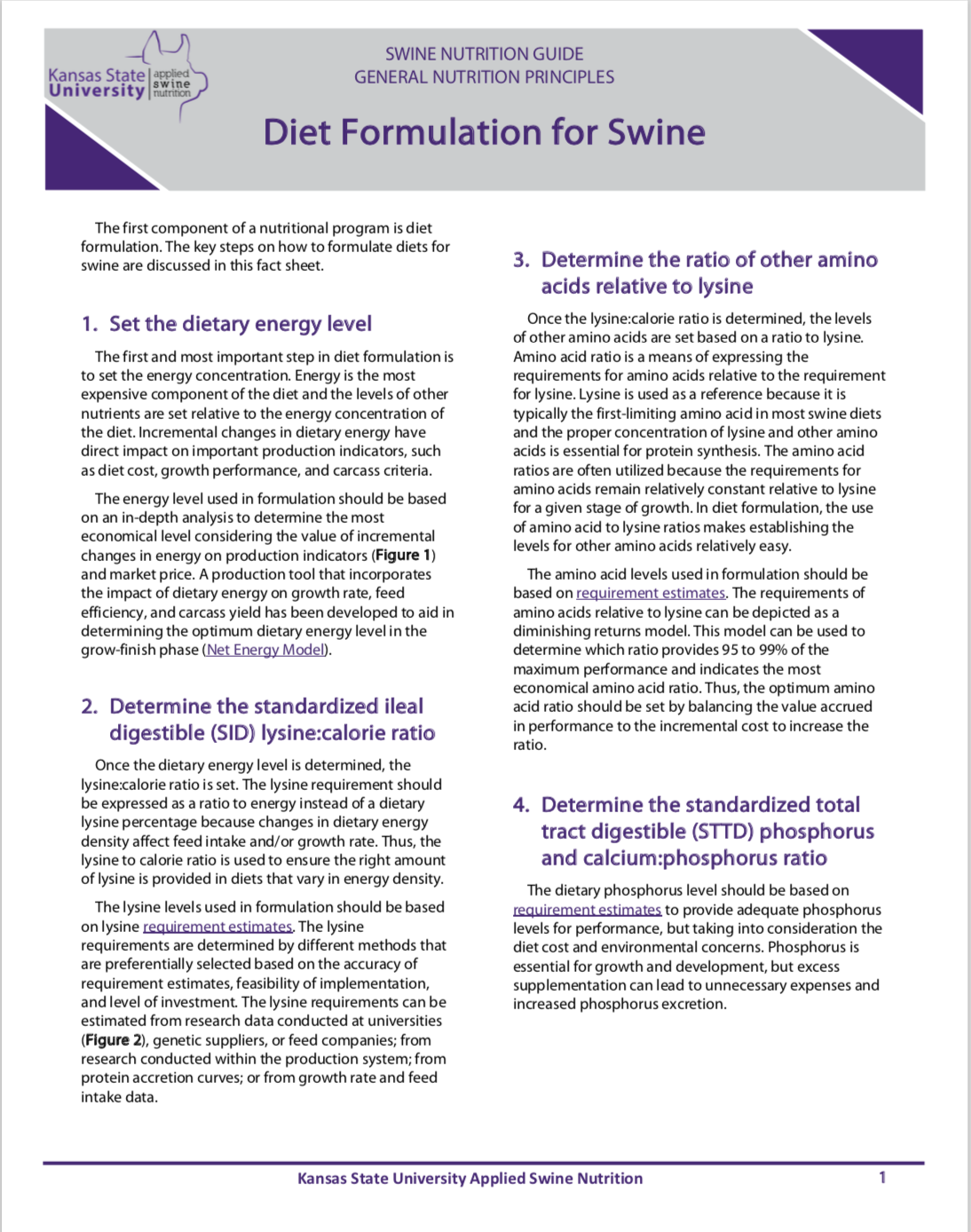Diet formulation
The first component of the nutrition program is diet formulation. The key steps on how to formulate diets consist on the following:
1. Set the dietary energy level
2. Determine the standardized ileal digestible (SID) lysine:calorie ratio
3. Determine the ratio of the other amino acids relative to lysine
4. Determine the standardized total tract digestible (STTD) phosphorus and calcium:phosphorus ratio
5. Set levels of vitamins, minerals, and other ingredients
Diet formulation steps
1. Set the dietary energy level
The first and most important step in diet formulation is to set the energy concentration. Energy is the most expensive component of the diet and the levels of other nutrients are set relative to the energy concentration of the diet. Incremental changes in dietary energy have direct impact on important production indicators, such as diet cost, growth performance, and carcass criteria.
The energy level used in formulation should be based on an in-depth analysis to determine the most economical level considering the value of incremental changes in energy on production indicators ( Figure 1 ) and market price. A production tool that incorporates the impact of dietary energy on growth rate, feed efficiency, and carcass yield has been developed to aid in determining the optimum dietary energy level in the grow-finish phase (Net Energy Model).
Figure 1. Equation to predict growth rate of grow-finish pigs fed varying energy levels. Every ±100 kcal NE/kg in dietary energy represents ±11.35 g or ±0.025 lb in average daily gain (Nitikanchana et al., 2015 doi:10.2527/jas.2015-9005).
2. Determine the standardized ileal digestible (SID) lysine:calorie ratio
Once the dietary energy level is determined, the lysine:calorie ratio is set. The lysine requirement should be expressed as a ratio to energy instead of a dietary lysine percentage because changes in dietary energy density affect feed intake and/or growth rate. Thus, the lysine to calorie ratio is used to ensure the right amount of lysine is provided in diets that vary in energy density.
The lysine levels used in formulation should be based on lysine requirement estimates. The lysine requirements are determined by different methods that are preferentially selected based on the accuracy of requirement estimates, feasibility of implementation, and level of investment. The lysine requirements can be estimated from research data conducted at universities ( Figure 2 ), genetic suppliers, or feed companies; from research conducted within the production system; from protein accretion curves; or from growth rate and feed intake data.
Figure 2. KSU lysine recommendations for grow-finish pigs (KSU Lysine Recommendations).
3. Determine the ratio of other amino acids relative to lysine
Once the lysine:calorie ratio is determined, the levels of other amino acids are set based on a ratio to lysine. Amino acid ratio is a means of expressing the requirements for amino acids relative to the requirement for lysine. Lysine is used as a reference because it is typically the first-limiting amino acid in most swine diets and the proper concentration of lysine and other amino acids is essential for protein synthesis. The amino acid ratios are often utilized because the requirements for amino acids remain relatively constant relative to lysine for a given stage of growth. In diet formulation, the use of amino acid to lysine ratios makes establishing the levels for other amino acids relatively easy.
The amino acid levels used in formulation should be based on requirement estimates.The requirements of amino acids relative to lysine can be depicted as a diminishing returns model. This model can be used to determine which ratio provides 95 to 99% of the maximum performance and indicates the most economical amino acid ratio. Thus, the optimum amino acid ratio should be set by balancing the value accrued in performance to the incremental cost to increase the ratio.
4. Determine the standardized total tract digestible (STTD) phosphorus and calcium:phosphorus ratio
The dietary phosphorus level should be based on requirement estimates to provide adequate phosphorus levels for performance, but taking into consideration the diet cost and environmental concerns. Phosphorus is essential for growth and development, but excess supplementation can lead to unnecessary expenses and increased phosphorus excretion.
The dietary calcium levels are set relative to phosphorus in a calcium:phosphorus ratio. The ratio of calcium to phosphorus is important because of the close association of both minerals. The dietary concentration of calcium affects the absorption and retention of phosphorus, particularly in diets with excess calcium and marginal phosphorus. Diets with excess calcium are not uncommon in swine diets because, unlike phosphorus, there is no economic and environmental concerns regarding dietary calcium. Using calcium:phosphorus ratio to set calcium levels is important to avoid an imbalance between the minerals, which is particularly important in diets with marginal levels of phosphorus.
5. Set levels of vitamins, minerals, and other ingredients
Finally, the levels of vitamins, minerals and any other ingredients are set in the diet formulation. Recommendations for trace minerals and vitamins levels are available at KSU Premix & Diet Recommendations.


